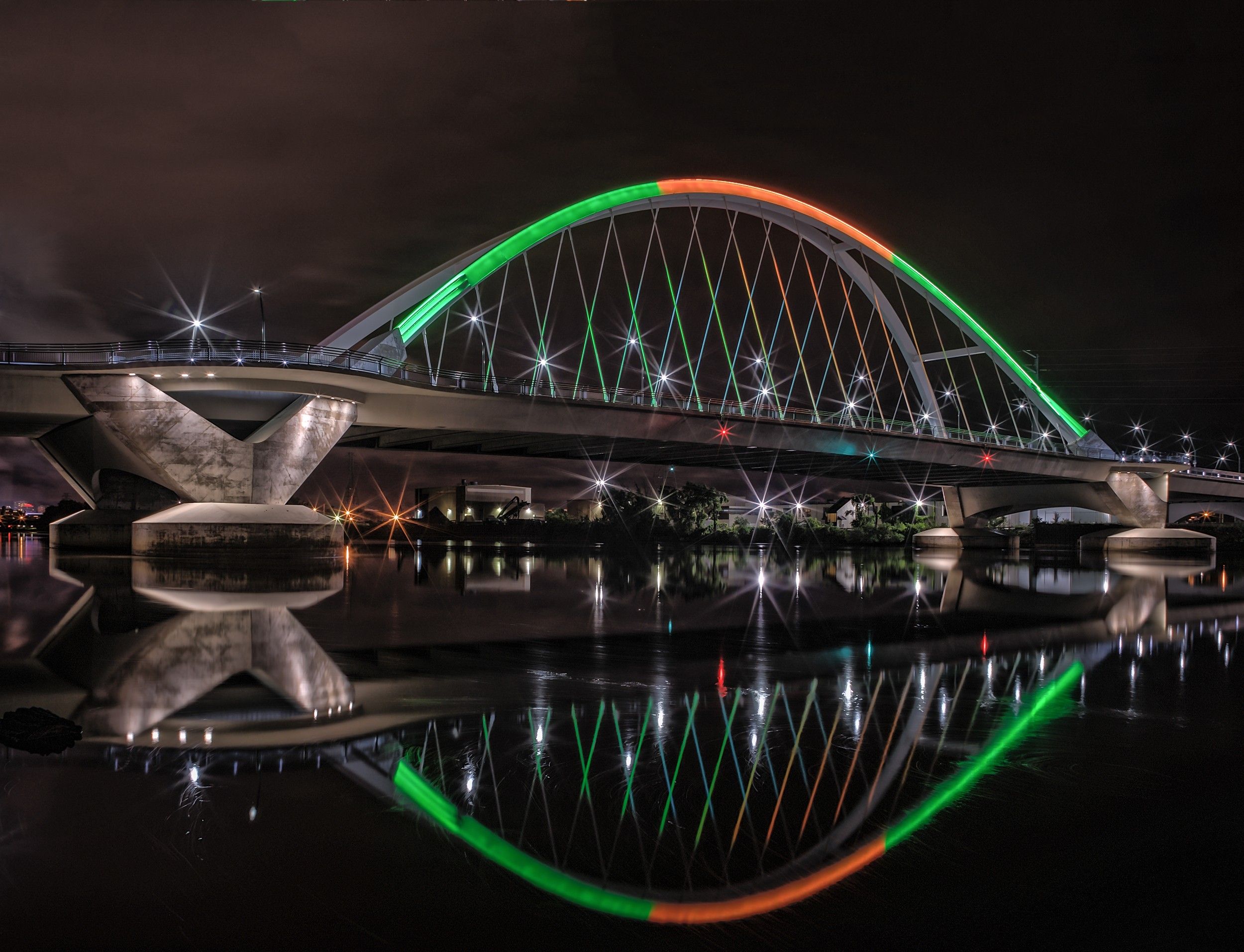In recent years, advancements in lighting technologies have literally changed the way we see the world. The familiar orange glow of sodium vapor streetlights is fading. The days of burning oneself on incandescent light bulbs are almost gone. The hauntings of fluorescent lights are fewer and farther between. A few years ago, Light Emitting Diodes were small, relatively dim, and expensive. The technology has evolved, and LEDs are quickly replacing everything from the typical household light bulb to the venerable neon tube.
One area that has greatly benefited from the use of LEDs is the aesthetic lighting that illuminates everything from buildings to bridges, and even waterfalls. These new lighting systems offer brighter and more even illumination of the subject, and easily allow the lighting to be changed for special occasions. As beautiful as the aesthetic lighting is, it can be challenging for photographers to adequately capture its ambiance.
In this article, we’ll discuss the following:
- Gear needed to capture the ambiance created by the aesthetic lights
- The challenges presented by dynamic aesthetic lighting
- Tips for scouting your subject and planning your photo shoot
- Considerations when choosing camera settings
- Post-processing ideas
Recommended Reading: If you’d like to learn more and improve your landscape photography, grab a copy of Photzy’s bestselling premium guide: Complete Landscape Photography
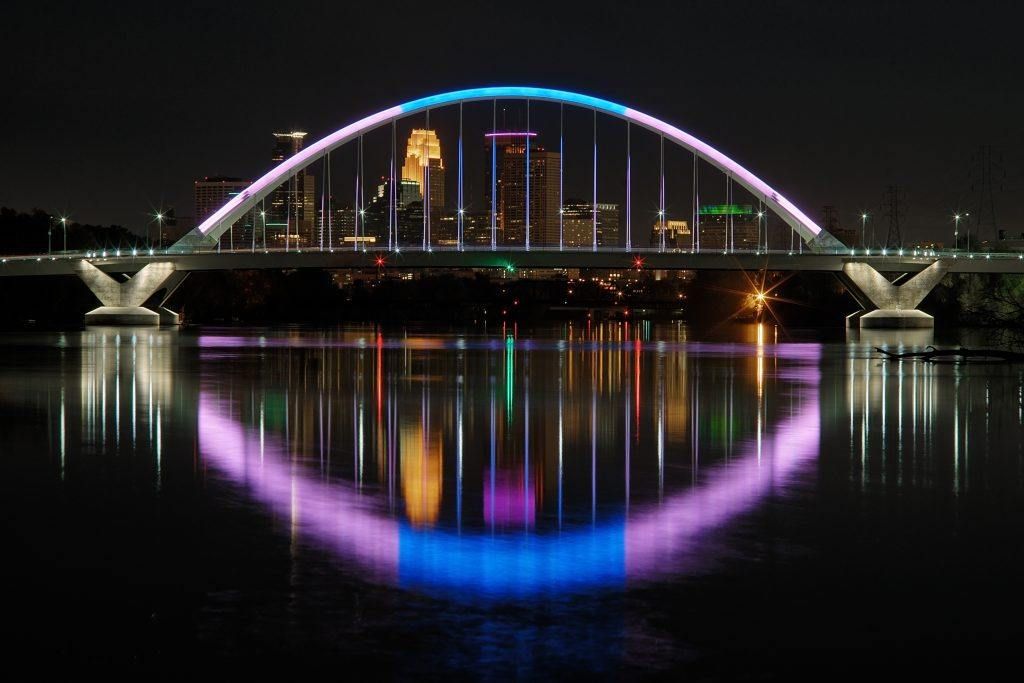
Photograph by Aaron Seefeld
As beautiful as the aesthetic lighting is, it can be challenging for photographers to adequately capture its ambiance.
Gear
Compulsory:
- A camera with manual mode.You’ll want to have full control over your settings.
- A lens with adequate focal length for your subject. Unless it’s part of your artistic vision, you don’t want to cut off part of the landmark, or make your viewers play “Where’s Waldo?”
- A tripod, or other means to stabilize your camera. It’s almost impossible to hand-hold a camera steady enough for exposures this long. Also, it will help if you decide to bracket your exposures.
- A remote shutter release. Even on a tripod, the camera moves when you press the shutter button. If you don’t have a remote shutter release, your camera’s self-timer can work.
- Spare batteries and memory cards. Long exposures drain batteries quickly, and you don’t want to run out of storage space mid-session.
Optional, But Useful Things to Bring Along Include:
- A flashlight. It’ll get dark, so you may want some help seeing where you’re going. It can also be used for light painting if you want to fill in some dark spots in the scene.
- A soft lens cloth. Condensation, fingerprints, and other things find their way on to the lens. You’ll want to be able to clear them off.
- A friend. It’s fun to share experiences like these with someone. They can also assist with the shoot and watch your back.
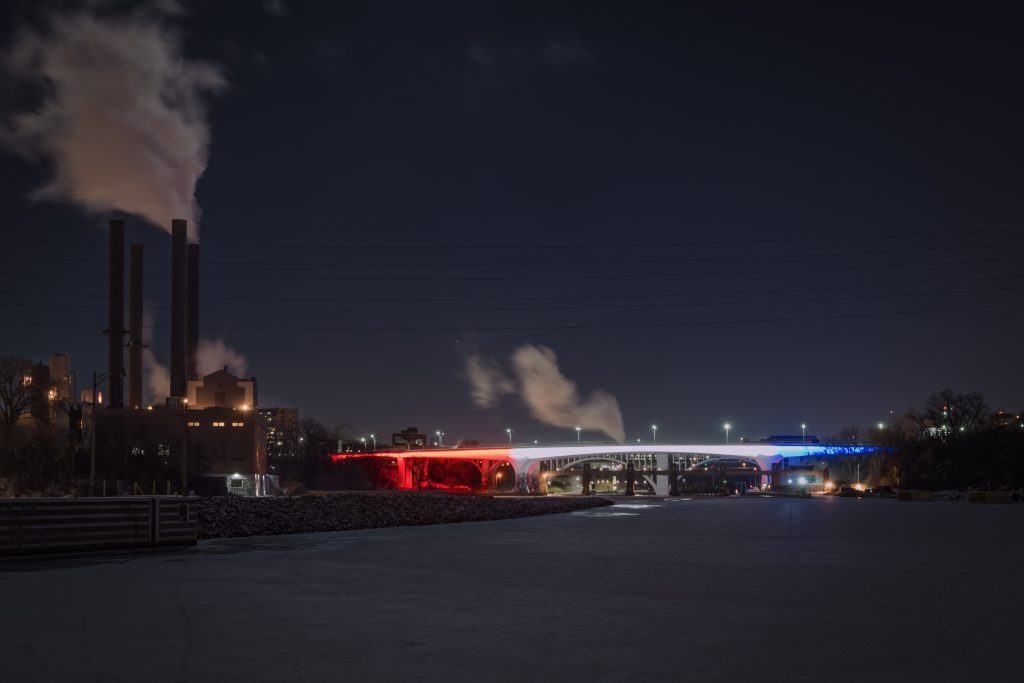
Camera Setup
You may not know exactly what aperture and shutter speed you’ll need before you arrive at the scene, but there are some camera settings you can take care of before you leave your house. Doing so will reduce how much you have to set up in the field and will reduce the chances of making a mistake.
- Shoot RAW files. Artificial light paired with low ambient light easily leads to clipped highlights and crushed shadows. Using a RAW file will allow you to recover the maximum amount of data possible while keeping the image clean.
- Set your LCD’s brightness to the lowest setting. The camera’s preview display is very deceiving in low light and will trick you into thinking the image is brighter than it really is. Rely on your histogram for determining correct exposure.
- Start with your metering mode set to matrix or evaluative. Switch to spot metering if you need to rein in the highlights.
- Try auto white balance first. Most new DSLRs and mirrorless cameras are pretty accurate in AWB, but LED lights can lead to a slightly cooler hue in the image. If the color is off while you’re shooting, set a custom white balance. If you’re shooting in RAW, you’ll be able to fine tune the color in post-production.
- Shoot in Manual mode. Extreme contrast can trick your light meter and result in either overexposed or underexposed shots in the automatic modes. Manual mode will allow you to fine tune the exposure based on what the histogram tells you.
- Set your ISO to the lowest value your camera offers. This will increase exposure time, but reduce noise and improve the contrast and color range in your image.
- Use Manual focus (or use back button auto focus). If you use your shutter button to achieve focus, there’s a chance the focal point will drift when you go to take the picture. For a single shot, that may not be a big deal. If you’re bracketing exposures for HDR, or looking to stitch a panorama, you want the focus to stay were you set it to reduce the chance of stacking/stitching errors.
- Bracket your exposures. This is optional, but it will give you much more flexibility in post-processing.
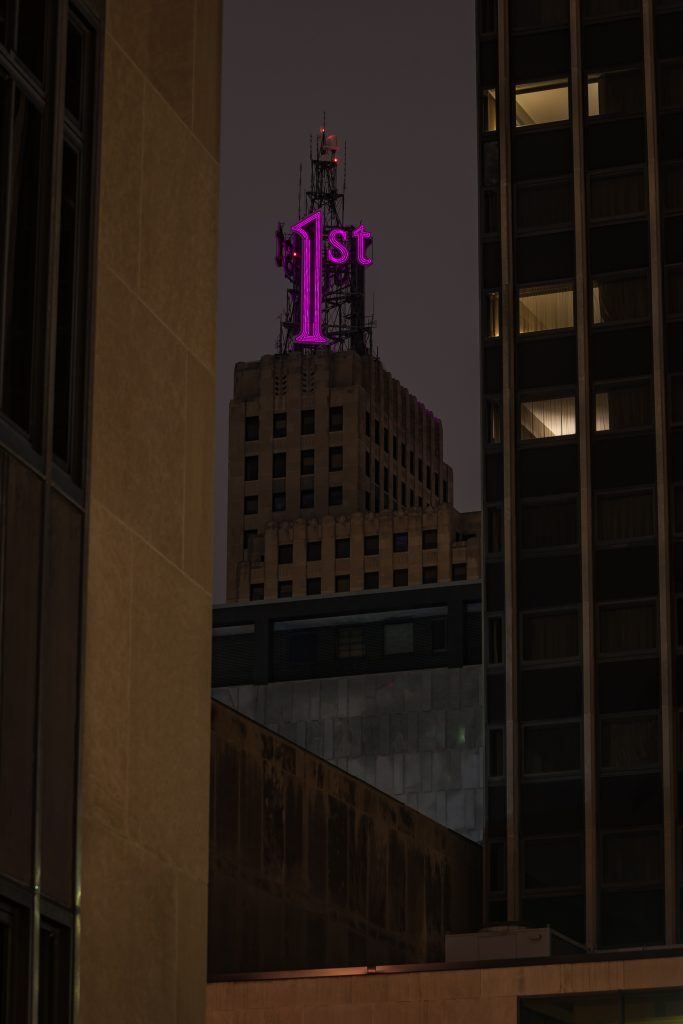
When Should I Go Out to Shoot?
Whenever the lights are on! Hours vary from landmark to landmark. Some lights come on at sunset and stay on until sunrise. Some are on set schedules, regardless of the ambient light. Others may be on 24/7. Some places will advertise their hours; for others, you’ll have to figure it out through trial and error or asking around.
You can capture outstanding images almost any time of day. The blue hour may be the most popular time to take these types of shots, but the golden hour and dark of night are excellent choices too.
Recommended Reading: If you’d like to learn more and improve your landscape photography, grab a copy of Photzy’s bestselling premium guide: Complete Landscape Photography.
How Can Dynamic Lighting Be a Problem?
The short answer is, because it changes! I can hear you asking, “So?” It’s a fair question. Let’s talk about some of the ways lighting can change, the challenges presented, and how to deal with all of it.
Different Colors
Most landmarks that utilize dynamic aesthetic lighting have a default color or pattern that illuminates them most of the time. However, the lighting can be changed for holidays, festivals, sports championships, or for any occasion. The image below shows the Lowry Avenue Bridge in North Minneapolis in its default color. The bridge is bathed in blue roughly 300 days a year. The remaining 65 days show off an array of colors from red, white, and blue on U.S. holidays, to red and pink on Valentine’s Day, to green on St. Patrick’s Day, and orange on Halloween. Add in the various color combinations requested by charities and awareness groups, and you could see any color in the visible spectrum. The variety adds to the fun of visiting the location, but if you show up hoping to get the “definitive” shot of a landmark, you may be disappointed to see something else. Conversely, if you’re planning to capture a special color scheme, you may find the default color instead.
You can capture outstanding images almost any time of day.
Fortunately, several landmarks publicly announce their schedule of special lighting events. The manner in which these announcements are made varies from landmark to landmark, but can usually be found on their website or social media accounts. Sometimes events get added at the last minute, or some sort of error leads to the wrong color being announced or displayed, but these resources help tremendously with planning.
If you can’t find a schedule, make an educated guess. If the landmark used (or did not use) special lighting on a holiday or annual event last year, they’ll
probably do the same thing this year. If a unique occasion comes up and other landmarks in the area change their lighting, the one you’re interested in may follow suit. Over time, you may notice a trend in which types of events get special lighting and which ones don’t.
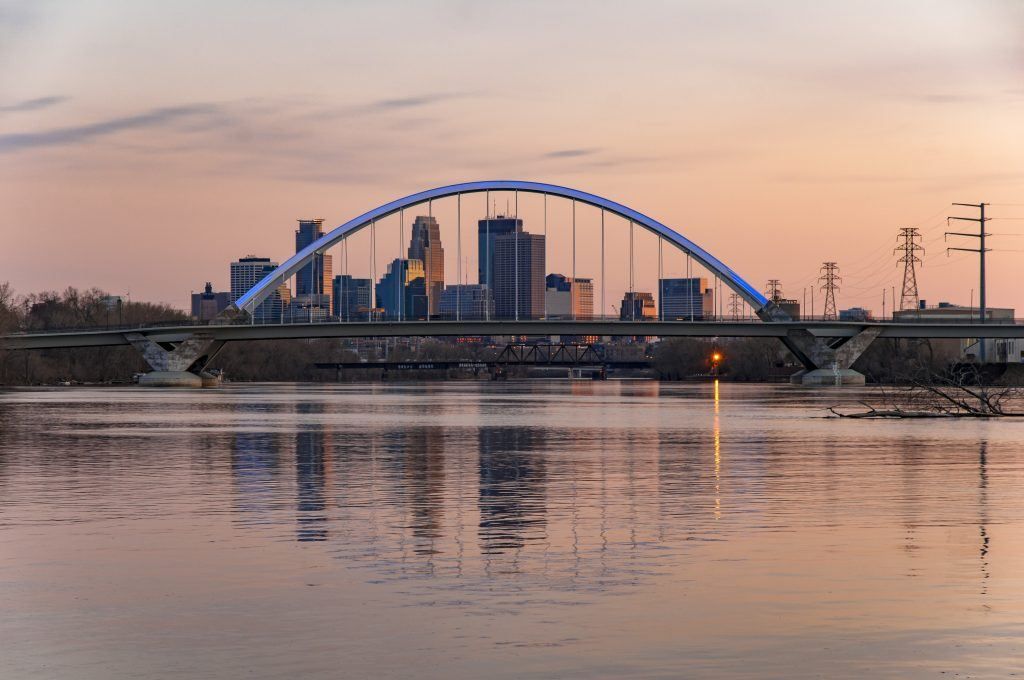
Photograph by Aaron Seefeld
Animated Light Sequences
Another challenge of photographing dynamic lighting is dealing with animated light sequences. They can be absolutely mesmerizing to watch with your eyes, but conveying the effect is very difficult in a still medium. When you photograph animated lights with the long exposures needed for low light photography, you can end up with murky blobs of color that trend towards white as the exposure increases.
To capture a particular moment of the show, you want the exposure to be as short as possible. Exactly how short depends on the speed of the animation and how much tolerance you have for light bleed. Experiment with the shutter speed until you like what you see. If the resulting image is too dark, you can balance the exposure by opening your aperture and/or using a higher ISO.
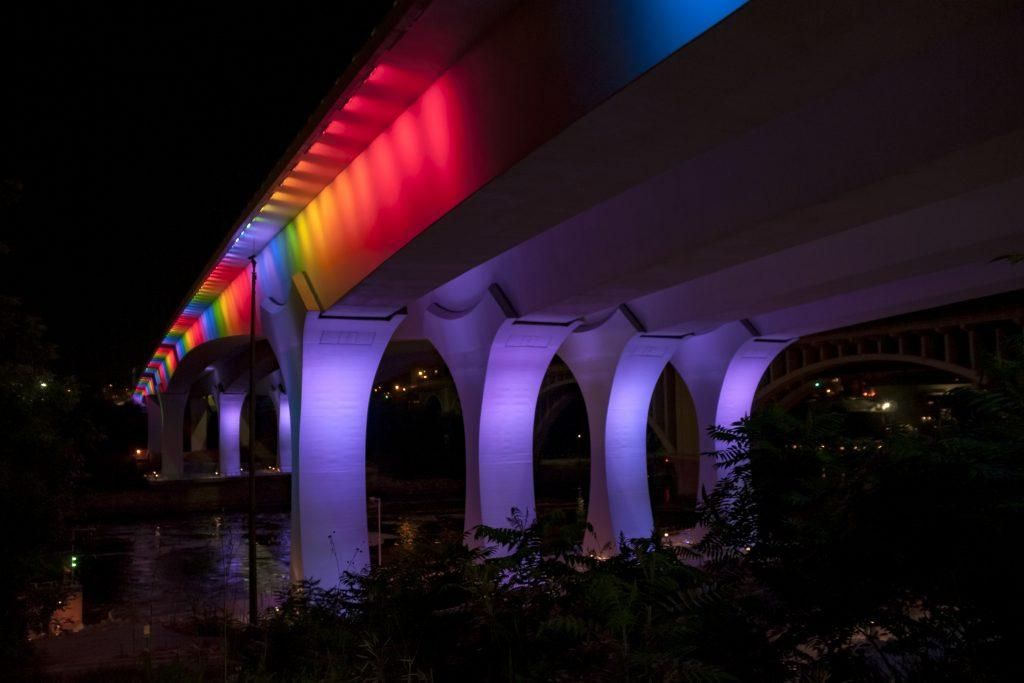
The image above shows the I-35W Bridge in Minneapolis in a rainbow color pattern. The pillars were a static purple color, but the rainbow along the deck scrolled from right to left. I limited the exposure to 1/10s to preserve the rainbow pattern. I opened the aperture to f/4 and boosted the ISO to 400 to get a little bit of detail in the river.
Blinking Lights
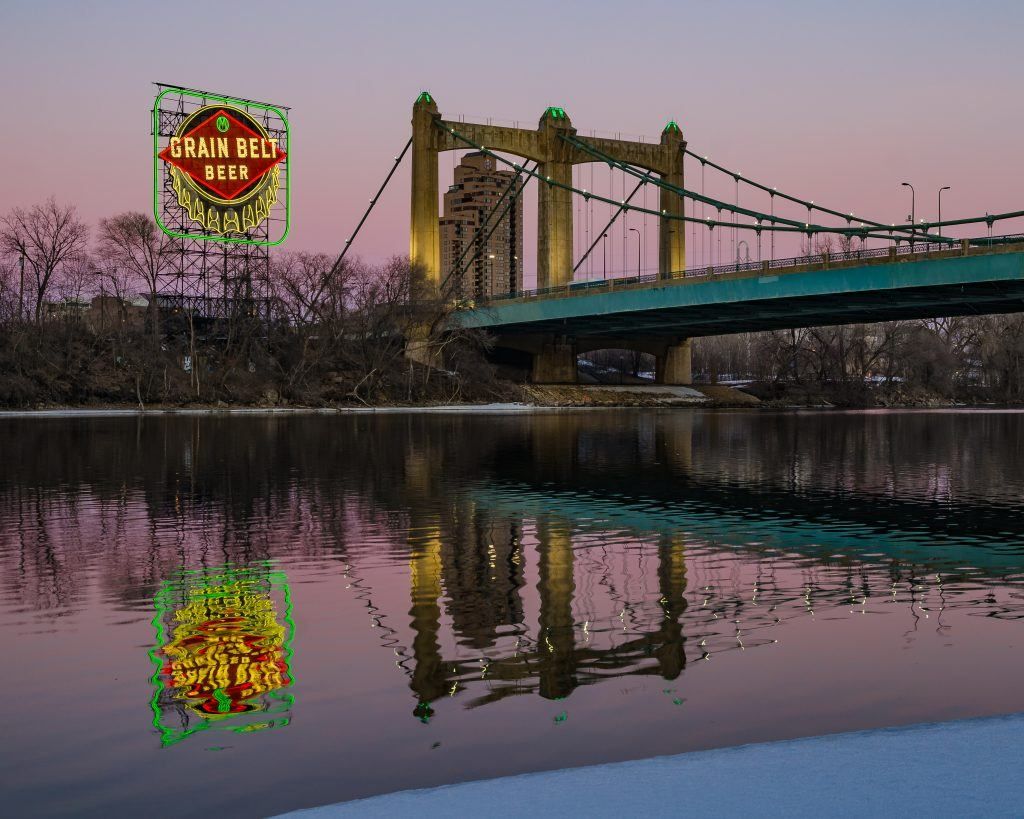
Blinking lights also put your photography skills to the test. If the lights are blinking in unison, it’s not so bad. If you’re not blowing out the highlights, the shutter speed isn’t much of a concern. You just have to make sure the lights come on at some point while the shutter is open. If the lights are sequenced, it can get more challenging. You’ll have to adjust your shutter speed to be short enough to only be open for the time when all the lights are lit or blinking in unison (assuming your goal is to capture the fully illuminated landmark). Adjust your ISO and aperture settings to balance the exposure. You also have to time your shot so you don’t capture part of the sequence where only part of the landmark it lit. If your shutter speed is too slow, or your timing is off, it’ll be obvious in the resulting image.
This image of the Grain Belt Beer sign in Minneapolis illustrates good timing and a short enough shutter speed. While most of the sign is always lit, the letters start off dark, then turn on one by one until GRAIN BELT is spelled out, then the word BEER lights up. All the letters then flash in unison twice before starting the cycle over. The cycle is 15 seconds long. It takes 9 seconds to spell out Grain Belt. All the letters flash for the remaining 6 seconds – one second on, one second off.
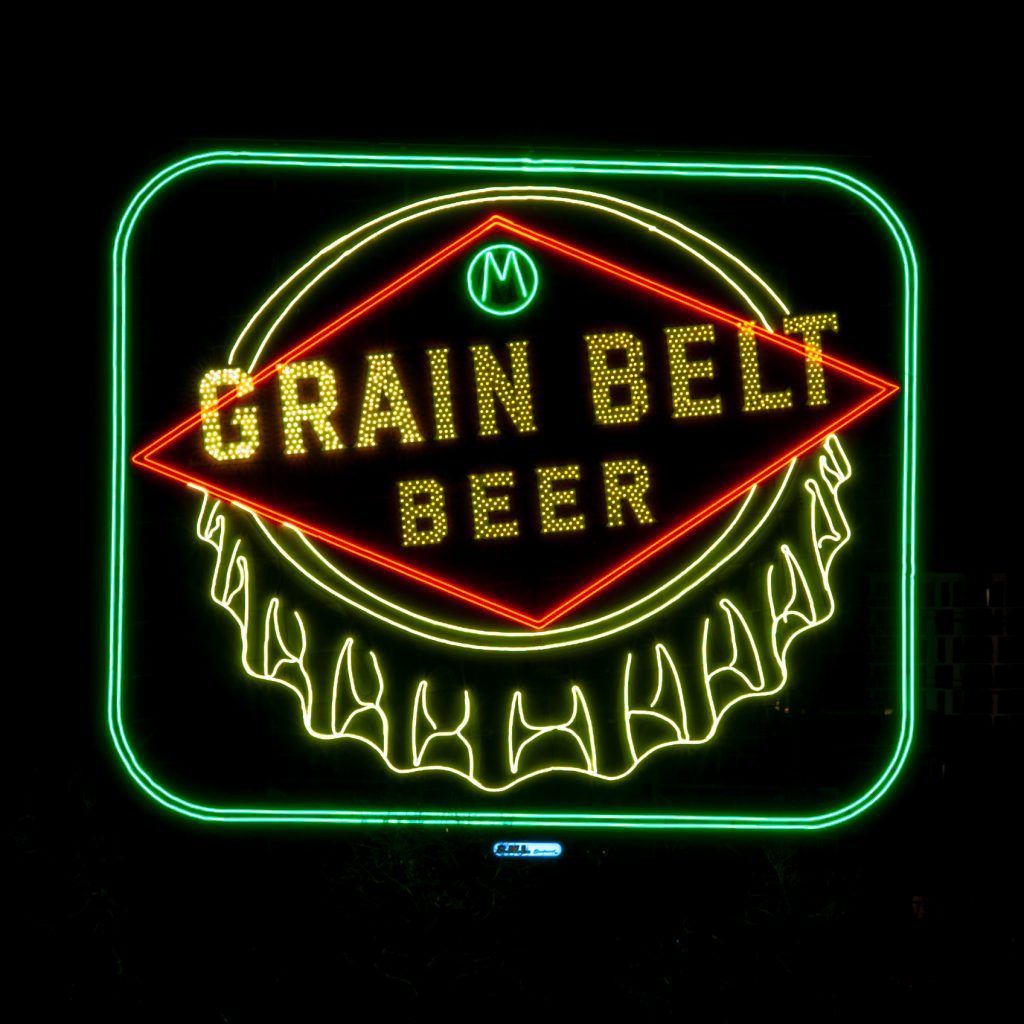
How does that help us? Still assuming our vision is to capture the entire sign lit up, it dictates that our shutter speed needs to be less than 6 seconds long, our exposure needs to start and end within the 6-second window where all the lights are in unison, and our shutter has to be open during at least one of the three 1-second intervals where all of the lights are on. If our exposure goes longer, or we mistime it, we’ll get uneven lighting or missing letters. The image above shows what it looks like when the exposure is started too late, or is too long. Notice how the GRA is brighter than the rest of the letters. If we change our goal to convey the dynamic nature of the lighting, this effect is exactly what we want!
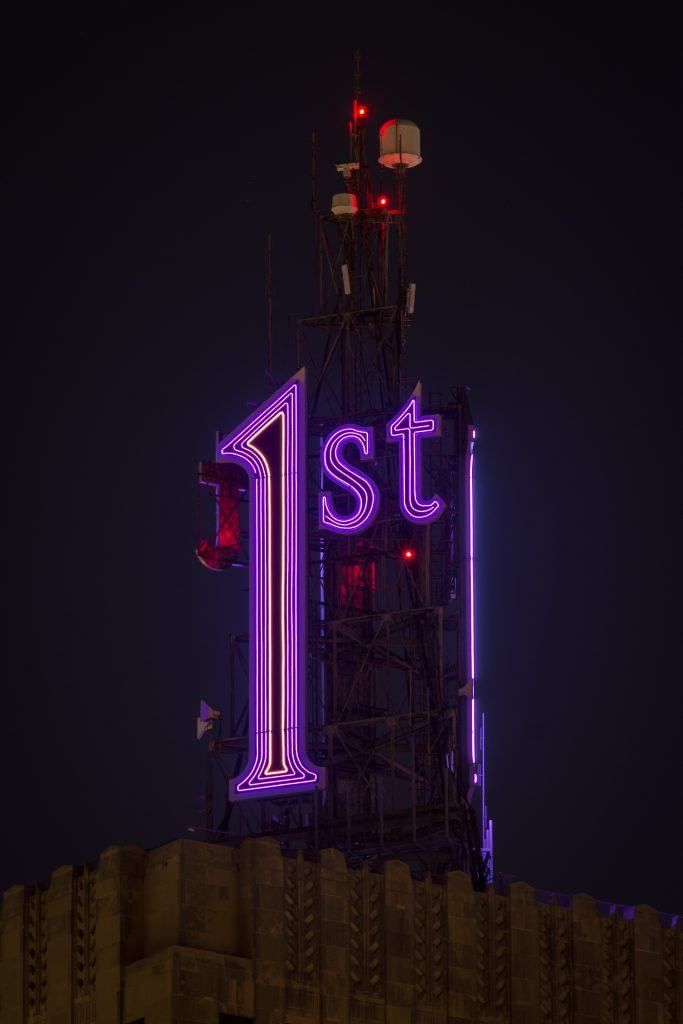
The image above illustrates the first three challenges we talked about. It was taken on September 11, 2017. Most of the landmarks around the Twin Cities were lit in red, white, and blue for Patriot Day. However, the Minnesota Vikings played their home opener that night, and the First National Bank Building elected to root for them. The sign has three faces arranged in a triangle, and only one face is lit at a time. The lit face “rotates” in a counterclockwise pattern. The sign’s timing had each face lit for four seconds before changing to the next one. To complicate matters, the gold segment would change to a different row on the ‘1’ every half second.
To get this shot, I got a little creative with my timing. I set my exposure to 8 seconds, which let me keep my ISO at 200 and my aperture at f/11. 7.9 seconds elapsed while the two faces away from me were lit. The exposure finished just after the visible face turned on, which gave me some detail in the dark building and kept the colors from washing out in the sign. It took a few tries before I got my timing right, but it was worth the effort.
Lighting Malfunctions
Despite advancements in durability and longevity, lights can still malfunction. I’ve seen everything from burned out bulbs, to flickering lights, rogue colors, and stuck animations. When you encounter this, you may want to explore other angles. If the landmark is multi-faceted, maybe another side works properly. If not, find an angle that minimizes the impact of the defect. If you’re so inclined, you may be able to do some work in post-processing to cover up the shortcomings.
Alternatively, get the angle you want and show off the flaws! Lighting irregularities are part of the experience, and can add some character to the shot. The first photo with the 1st sign, the colorful bridge earlier, and the last image at the end of this article, exhibit either unlit light segments or malfunctioning segments that are displaying the wrong color.
Post-Processing
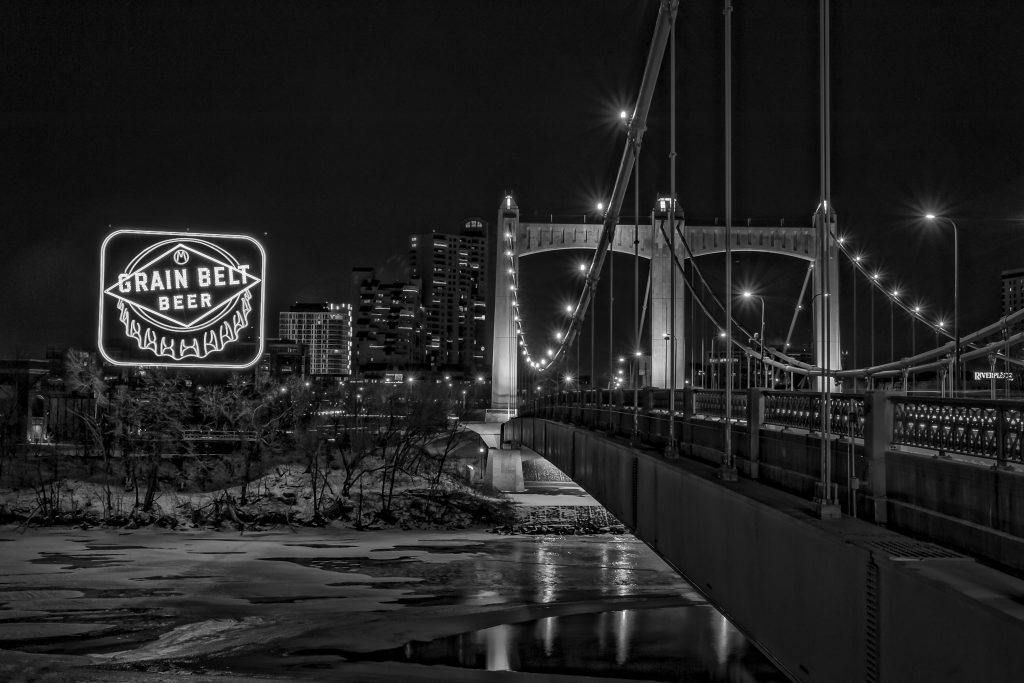
Photograph by Aaron Seefeld
Since you took care to get properly exposed images with highlights under control and details in the shadows, your normal post-processing routine will yield fantastic results. If you bracketed your exposures, you can get creative and experiment with HDR and other exposure blending techniques.
These types of scenes can also make for some compelling monochrome images. You may not have a full range of mid-tones to work with, but you’ll still have plenty of contrast. Many landmarks will also offer great textures and details to enhance the image. I know I’ll get some flak for saying this, but if the other conditions for a good monochrome image are met, it can also be a way to work around a color scheme you don’t particularly care for.
These types of scenes can also make for some compelling monochrome images. You may not have a full range of mid-tones to work with, but you’ll still have plenty of contrast.
On the evening I took the image above, the Grain Belt sign was lit in purple and gold in support of the Vikings as they prepared for a playoff game that weekend. Personally, I’m not a Vikings fan, but I do get excited about special lighting. The sign had only been illuminated for two weeks after being dark for 21 years, so I still wanted to photograph it. It was well after sunset by the time I arrived, so the contrast between the lights and river was too much for a single exposure. I opted to use HDR software to blend 7 exposures ranging from -2 to +2 on my camera’s meter. I chose monochrome to make it look like this shot could have been taken on any winter night.
Recommended Reading: If you’d like to learn more and improve your landscape photography, grab a copy of Photzy’s bestselling premium guide: Complete Landscape Photography.
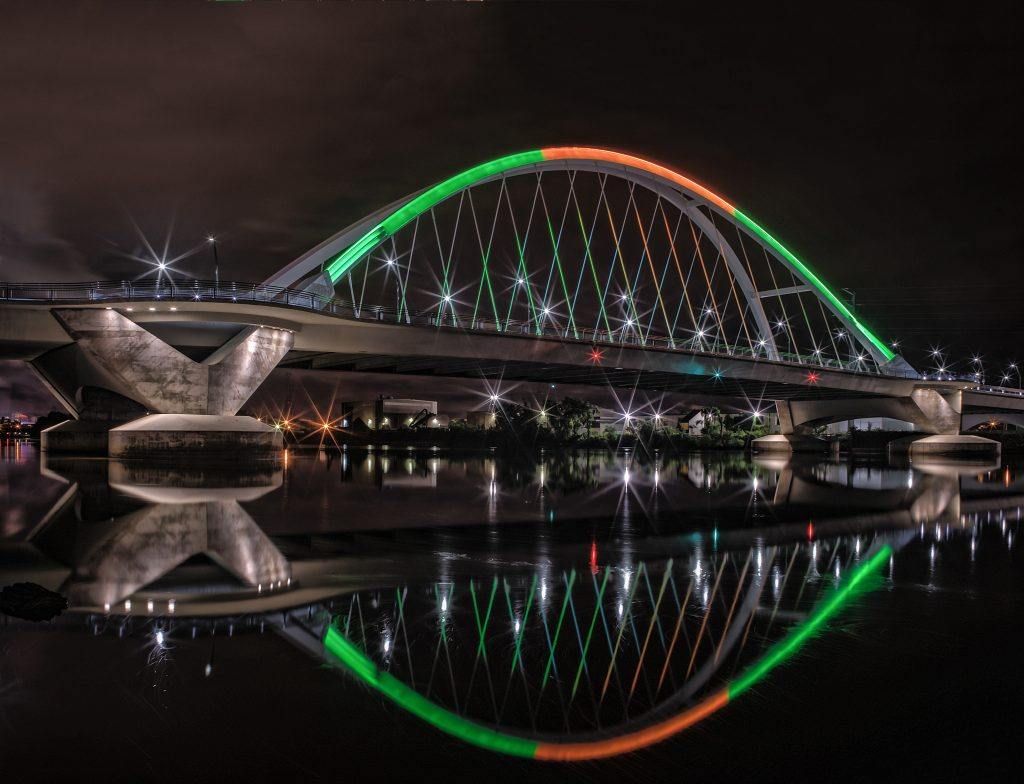
Try It Out!
- Find a landmark that utilizes dynamic aesthetic light and plan for when you’re going to go and how you want to frame it.
- Grab the necessary gear, set what you can on your camera, and head to the scene.
- Scout the lighting on your subject and set your shutter speed, aperture, and ISO to get the best exposure possible. Make sure the highlights are under control and then try to get detail in the shadows.
- Bring the image to life using your normal post-processing routine, or get creative with exposure blending techniques, monochrome conversion, or any other effects you can think of.
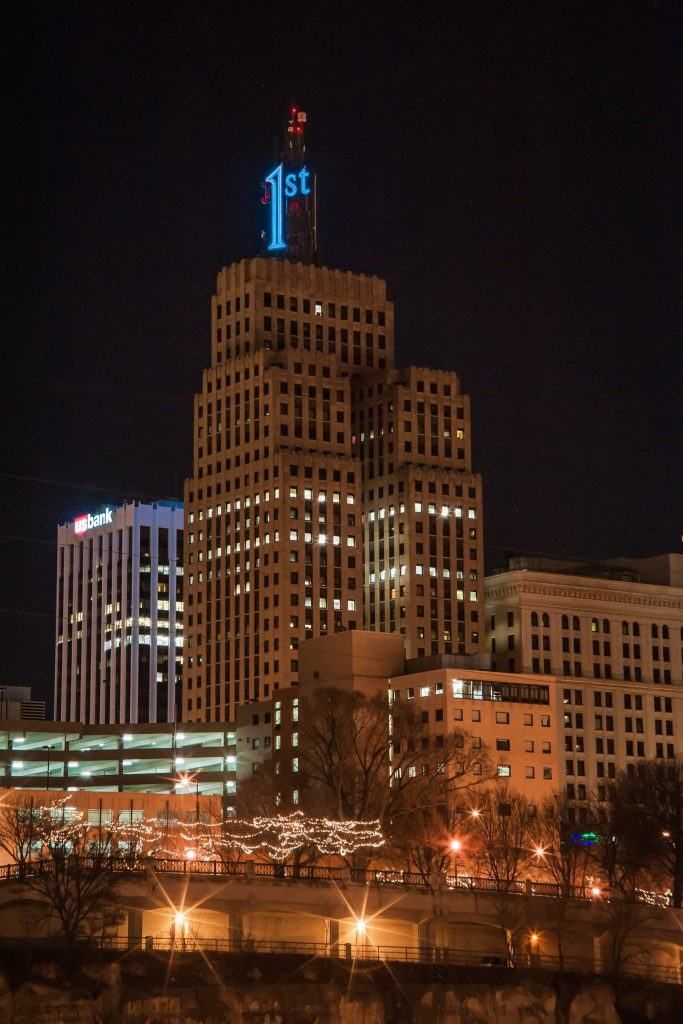
Self-Check Quiz:
- Why is dynamic lighting a challenge for photographers?
- What time of day is best for taking pictures of aesthetic lighting?
- What’s the best way to know whether a landmark will be in its default color or a special color scheme when you go to photograph it?
- Why is timing important when photographing animated displays?
- True or False: If you encounter malfunctioning aesthetic lights, the scene is not worth shooting.
- True or False: Even the best single exposure can still result in blown highlights or clipped shadows.
Share with your friends:
Posted in:


